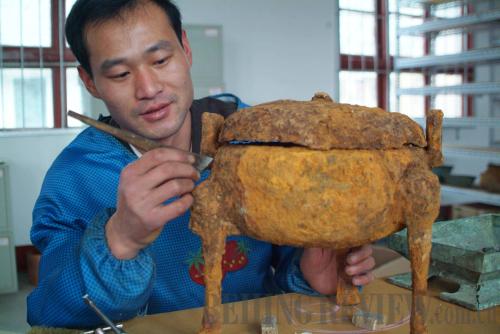|
 |
|
EXPERTISE: An archaeologist restores ironware from the Western Han Dynasty unearthed in central China (HAO TONGQIAN) |
The recent archaeological find of the tomb of Cao Cao (155-220), a renowned warlord and politician of the late Eastern Han Dynasty (206 B.C.-A.D.220) in Anyang City in central China's Henan Province came among unprecedented public interest about China's national antiques and treasures.
Fueled by a rapidly growing Chinese art market and popular TV programs on antique authentication and investment, an increasing number of wealthy Chinese have become interested in collecting.
In addition, the country has witnessed a surge in attendance at museums nationwide, particularly in China's northwestern region, because of major change in China's museum sector since the beginning of 2008—a majority of public museums are now required to admit visitors for free.
Better protection of treasures housed in museums is now seemingly guaranteed by generous government funding, but the State Administration of Cultural Heritage (SACH) found, during its third national on-the-spot cultural heritage survey, more than 20,000 registered items of unmovable cultural relics had been destroyed since the completion of the second survey in 1985.
The reasons behind the losses reveal many challenges policymakers, experts and museum curators have to deal with to better protect and preserve these "cultural genes" of China's civilization.
Survival in museums
By the end of 2009, a total of 1,447 museums and memorials had opened to the public free of charge, accounting for 76 percent of all museums, memorials and national patriotism education bases under the administration of the SACH, according to Shan Jixiang, Director of the SACH, at a meeting on December 22.
In 2009, the central budget poured 4.86 billion yuan ($711.57 million) into the protection of cultural relics, almost doubling that of the previous year. In addition, 2 billion yuan ($292.8 million) was designated to subsidize key museums and memorials at provincial or municipal levels that now offer free admission, encouraging them to improve management and services and hold a greater number of exhibitions of varied themes, Shan said.
He also said that the Central Government is selecting eight museums and would make them representative of China's museum sector with finance from the central budget.
Thanks to this free admission policy, visitors to 500 major museums reached 118 million in 2008, or 1.74 times that in 2007, and visitors to some of them even increased 10-fold over the previous year.
But the increase of visitors has created pressure on curators. The environment for the protection of museum items, in which temperature, humidity, radiation, air pollution, insects and mildew all play a part, is also affected by visitor traffic flow. China lags behind many countries in basic, applicable study in curation, said Wu Laiming, a SACH researcher.
Of these factors, Wu said the air pollution that has accompanied China's high growth in recent years has accounted for aging, deterioration and even decomposition of museums' cultural relics. Smaller, more enclosed environments in exhibition halls, display cases and depots, in particular, had greater effects. "The more the visitors we have, the louder 'noise' is. This leads to changes in air temperature and humidity, and all these provide new challenges," Wu said.
Wu and his colleagues are now working on ascertaining changes the flow of visitor traffic have on the environment in show areas, in hope of working out a calculation model for ideal visitor traffic flow and routes in any public museum.
At present, museums built on sites of ancient architecture and historic ruins do not offer free admission to the public, to guarantee the security of relics and effective traffic control.
Fire is another threat to the security of museum items, as well the safety of visitors. A survey done by the SACH in 2009 indicated that of 2,011 key cultural relics under state-level protection and 246 major museums, only 27.47 percent and 55 percent of them respectively met requirements for fire alarm and sprinkler systems.
China now boasts a total of 2,900 museums of considerable size nationwide, of which 386, or 13.3 percent, are registered private museums. While the Central Government is now widely subsidizing public museums to offer citizens free admission, private museums have to survive on their own resources.
| 